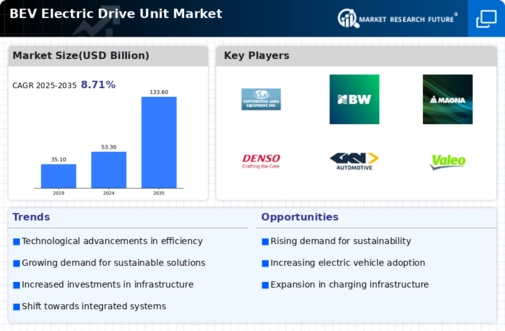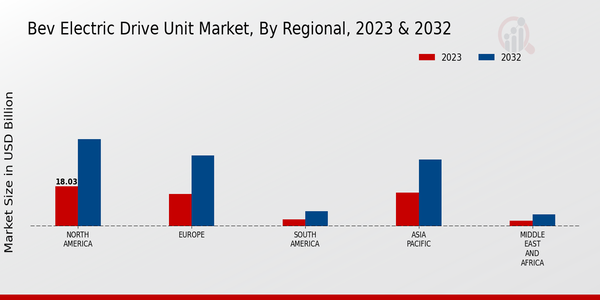Market Growth Projections
The Global BEV Electric Drive Unit Market Industry is projected to experience substantial growth over the next decade. With a market value expected to reach 53.3 USD Billion in 2024 and 133.6 USD Billion by 2035, the industry is poised for significant expansion. The anticipated CAGR of 8.71% from 2025 to 2035 highlights the increasing investment and interest in electric drive units. This growth trajectory reflects the convergence of various factors, including technological advancements, regulatory support, and changing consumer preferences. As the market evolves, stakeholders are likely to capitalize on emerging opportunities.
Rising Environmental Awareness
The growing awareness of environmental issues among consumers is a significant driver of the Global BEV Electric Drive Unit Market Industry. As individuals become more conscious of their carbon footprints, the demand for electric vehicles, which offer lower emissions compared to traditional vehicles, is increasing. This shift in consumer behavior is supported by educational campaigns and advocacy for sustainable practices. Consequently, manufacturers are responding by enhancing their electric drive unit offerings to meet this demand. The trend towards sustainability is expected to continue influencing market dynamics, contributing to the overall growth of the electric drive unit sector.
Expansion of Charging Infrastructure
The development of comprehensive charging infrastructure is essential for the growth of the Global BEV Electric Drive Unit Market Industry. As more charging stations are established, consumer confidence in electric vehicles increases, leading to higher adoption rates. This expansion is supported by both public and private investments, which aim to create a robust network of charging facilities. The availability of fast-charging options enhances the convenience of owning electric vehicles, further driving demand for electric drive units. The synergy between charging infrastructure and electric vehicle adoption is likely to propel the market forward in the coming years.
Growing Demand for Electric Vehicles
The increasing consumer preference for electric vehicles is a primary driver of the Global BEV Electric Drive Unit Market Industry. As environmental concerns rise, more consumers opt for electric vehicles, which are perceived as cleaner alternatives to traditional combustion engines. This trend is reflected in the projected market value of 53.3 USD Billion in 2024, indicating a robust demand for electric drive units. Governments worldwide are also implementing incentives to promote electric vehicle adoption, further bolstering this market. The shift towards sustainability is likely to continue, contributing to the industry's growth and expansion.
Government Regulations and Incentives
Government policies and regulations aimed at reducing carbon emissions are pivotal in driving the Global BEV Electric Drive Unit Market Industry. Many countries are setting ambitious targets for electric vehicle adoption, supported by financial incentives such as tax credits and rebates for consumers. These initiatives not only encourage consumers to switch to electric vehicles but also stimulate manufacturers to invest in electric drive unit production. As a result, the market is likely to expand, with projections indicating a market value of 133.6 USD Billion by 2035. This regulatory environment fosters a conducive atmosphere for growth in the electric drive unit sector.
Technological Advancements in Electric Drive Units
Technological innovations play a crucial role in shaping the Global BEV Electric Drive Unit Market Industry. Advances in battery technology, electric motor efficiency, and power electronics have led to enhanced performance and reduced costs of electric drive units. For instance, improvements in energy density and charging speed are making electric vehicles more appealing to consumers. As manufacturers invest in research and development, the market is expected to witness a surge in innovative products, which could drive growth. The anticipated CAGR of 8.71% from 2025 to 2035 suggests that these advancements will significantly influence the industry's trajectory.








